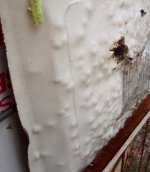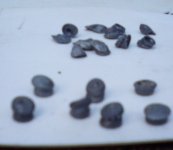How many FPE are needed to get a pellet to deform…?
I’ve often wondered why pellet manufacturers don’t make softer “hunting” pellets, from softer lead, which will deform, mushroom and dump all their energy into the target, there by helping with hydrostatic shock, making bigger holes, doing more damage to vital organs etc and lessening the chance of a pass through and the possibility of damaging things behind the target (I’m thinking about pest control here).
So I tested some .177 pellets in my sons little Gamo Delta Fox.
I tested some 8.44gr JSB exacts which leave the muzzel at 451fps producing 3.8FPE.
I also tested some JSB Hades 10.34gr which will be slightly slower, but probably produce about the same fpe, let’s call it 4FPE.
The results were the same for both.


At these very low powers, the pellets completely deform and turn into smarties, or M&M’s for those who don’t know what a smart is.
Imagine if they performed the same way hitting a rat or a starling!
So, is the lead soft enough??? With 3.8FPE a steel plate at 10m completely flattens a pellet, but a rat or bird dosent provide enough resistance to get the pellet to deform and dump energy. They usually pass through pretty much unchanged. Are our pest targets too soft?
I think we need softer pellets for close range hunting/pesting.
Yes I know velocity is a major factor, those same 10.34gr hades at 950fps will mushroom going through a rat, but that rat better be standing in an open paddock, with at least another paddock behind that one, because ur never going to see that pellet again…
Same pellet and same rat in a milking shed… hummmmm
And yes of course pellet shape also plays a huge role in how that pellet performs, mushrooms and dumps energy. I wish they could make a soft hollow point pellet that groups as accurately as a domed pellet, mushrooms to twice the caliber, dumps all its energy and ever exits…
Does anyone have an even lower powered air rifle/pistol so we can continue testing?
Try keep it .177 and steel plate pellet trap at 10m, and for the sake of continuity try use Exact and Hades if you can.
Pete.
I’ve often wondered why pellet manufacturers don’t make softer “hunting” pellets, from softer lead, which will deform, mushroom and dump all their energy into the target, there by helping with hydrostatic shock, making bigger holes, doing more damage to vital organs etc and lessening the chance of a pass through and the possibility of damaging things behind the target (I’m thinking about pest control here).
So I tested some .177 pellets in my sons little Gamo Delta Fox.
I tested some 8.44gr JSB exacts which leave the muzzel at 451fps producing 3.8FPE.
I also tested some JSB Hades 10.34gr which will be slightly slower, but probably produce about the same fpe, let’s call it 4FPE.
The results were the same for both.
At these very low powers, the pellets completely deform and turn into smarties, or M&M’s for those who don’t know what a smart is.
Imagine if they performed the same way hitting a rat or a starling!
So, is the lead soft enough??? With 3.8FPE a steel plate at 10m completely flattens a pellet, but a rat or bird dosent provide enough resistance to get the pellet to deform and dump energy. They usually pass through pretty much unchanged. Are our pest targets too soft?
I think we need softer pellets for close range hunting/pesting.
Yes I know velocity is a major factor, those same 10.34gr hades at 950fps will mushroom going through a rat, but that rat better be standing in an open paddock, with at least another paddock behind that one, because ur never going to see that pellet again…
Same pellet and same rat in a milking shed… hummmmm
And yes of course pellet shape also plays a huge role in how that pellet performs, mushrooms and dumps energy. I wish they could make a soft hollow point pellet that groups as accurately as a domed pellet, mushrooms to twice the caliber, dumps all its energy and ever exits…
Does anyone have an even lower powered air rifle/pistol so we can continue testing?
Try keep it .177 and steel plate pellet trap at 10m, and for the sake of continuity try use Exact and Hades if you can.
Pete.

